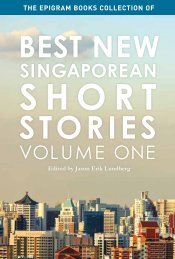View Sample - Epigram Books
View Sample - Epigram Books
View Sample - Epigram Books
You also want an ePaper? Increase the reach of your titles
YUMPU automatically turns print PDFs into web optimized ePapers that Google loves.
xxxxidiscourses, in quasi-Brechtian direct presentation, about the technique,effect and philosophy of that punitive measure. His ruminations on hisunusual vocation punctuate the proceedings, juxtaposing clear-headedlogic with the mounting racial stereotyping within that office setting.To prevent audience identification with any one perspectiveor mindset, Tan assembles an eclectic group: an American who mayor may not be guilty of neo-imperialism (Jim), a tight-lipped noncommittalBrit whose reticence may be the result of cultural reserve asmuch as an unvoiced disdain for the fumbling ex-colonised (Neville),an “accommodating” Singapore girl who doesn’t speak Hokkien andmay be culturally atrophied or at least has her own romantic motives(Sharon), another Singapore girl who may or may not have a Pinkertoncomplex (Cherie), and finally, two hot-blooded Singapore maleseager to prove their mettle in a workplace dominated by white men,and consequently harbouring much racial resentment, except that itremains unstated in one case (Peter) and brimming under the surfacein the other (Huat).Taking into account the glut of agendas and subterfuges hidingbeneath the veneer of collegiality, the audience can never ascertain ifthe racism that comes to a head at the play’s climax is profound or theunfortunate outcome of the personal made political. Is Huat truly astuteor merely resentful when he thinks the vandal is lucky to be American,an observation doubly relevant when he later wonders if their firmwould have clinched the BMW contract had it been named “Tan, Limand Mohamed” instead of “Beckman, Horton and Jones”? Is Jim beingthe ugly white boss by hitting on the girlfriend of the subordinate hewishes to groom as his heir or does he just believe, in the best Americanconvention, may the best man win? Has Cherie in fact rejected Peterbecause of his personality rather than his skin colour? Tan compoundsthese issues by incorporating heartlander gossip and speculation ofthe corner coffee shop ilk in his random references, such as when Huatand Peter suggest that racism already rears its head in the purportedlyharmonious multiculturalism of Singapore: the SAF convenientlyoverlooks the Malays; the MFA thinks its Indian representation is toostrong and is hesitant to recruit more.Amid mutual accusations of “othering” by the characters, thefeminisation of the East is underlined in a postcolonial context by Huatwho attempts to re-assert his masculinity by telling Peter, who has losthis girlfriend to a white Westerner, that he has performed cunnilinguson a Caucasian woman, an anecdote aptly couched in the Hokkiendialect to exclude the foreigner in a concomitant re-appropriation oflanguage. That Fay is subtly equated with Cherie in this play (she asthe booty fought over by the two men; he as the object of political andjudicial tussle between two countries) further serves to emasculatehim as the victim of disparate jingoisms who has to capitulate to theministrations of the phallic “rotan”.Hence, the viewpoint on both racism and punishment is constantlyshifting and the reader/spectator finds himself often agreeing withwhatever was last spoken. With the audience consciously pulled indifferent directions, the volatile space between the various discoursesand positions undermines the audience’s own confidence. In fact,the sophisticated debate among the well informed characters can bereduced to nothing more than the territorial struggles of two male packanimals, in this case, Jim and Peter, over a female, Cherie, and endsup exposing the pathos of the alpha male. Likewise, the audience findsthemselves curiously concurring with the stance of the flogger, whogains in humanity with each of his speeches, in contrast to the othercharacters who increasingly lose their grasp on reason and decorum.The cyclical connotations of the drama in Machine, whereeverything seems to have happened before in another place andtime and involved different personae of the four protagonists (thetwo men moving on to other “repair jobs” while the two women findother things broken in their lives that require fixing) foreshadow theirrepetition and recurrence. In all instances, it is as if Tan is reiteratingthe late poet-philosopher, George Santayana, who said, “He whodoes not heed the lessons of history is condemned to repeat them.”Despite their bruises, betrayals and broken hearts, the characters inMachine will replay those gender games over and again, with nocloser communication between the sexes, even though Tan has givenus much fodder for thought in the process.
















